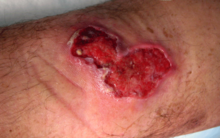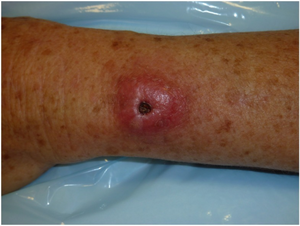Mycobacterium ulcerans
| Mycobacterium ulcerans | |
|---|---|

| |
| Scientific classification | |
| Domain: | Bacteria |
| Phylum: | Actinomycetota |
| Class: | Actinomycetia |
| Order: | Mycobacteriales |
| Family: | Mycobacteriaceae |
| Genus: | Mycobacterium |
| Species: | M. ulcerans
|
| Binomial name | |
| Mycobacterium ulcerans MacCallum et al., 1950
| |
Mycobacterium ulcerans is a species of bacteria found in various aquatic environments. The bacteria can infect humans and some other animals, causing persistent open wounds called Buruli ulcer. M. ulcerans is closely related to Mycobacterium marinum, from which it evolved around one million years ago, and more distantly to the mycobacteria which cause tuberculosis and leprosy.
Description
Mycobacterium ulcerans are rod-shaped bacteria.[1] They appear purple ("Gram positive") under Gram stain and bright red ("acid fast") under Ziehl–Neelsen stain.[1] On laboratory media, M. ulcerans grow slowly, forming small transparent colonies after four weeks.[1] As colonies age, they develop irregular outlines and a rough, yellow surface.[1]
Taxonomy and evolution
Mycobacterium ulcerans is a species of mycobacteria within the phylum Actinomycetota. Within the genus Mycobacterium, M. ulcerans is classified as both a "non-tuberculous mycobacterium" and a "slow-growing mycobacterium".[2]
| |||||||||||||||||||||||||||
| A cladogram showing the relationships among the mycobacteria that cause disease in humans.[3] |
M. ulcerans likely evolved from the closely related aquatic pathogen Mycobacterium marinum around one million years ago.[4] The two species are genetically very similar, and have identical 16S ribosomal RNA genes.[5] However relative to M. marinum, M. ulcerans has undergone substantial genome reduction, shedding over a thousand kilobases of genetic content including nearly 1300 genes (23% of the total M. marinum genes) and sustaining the inactivation of an additional 700 genes.[6] Some of these genes were inactivated by the proliferation of two mobile genetic elements, called "IS2404" (213 copies) and "IS2606" (91 copies), neither of which are present in M. marinum.[6] Additionally, M. ulcerans has acquired a 174 kilobase plasmid, termed "pMUM001", which is involved in the production of the toxin mycolactone.[6] Other closely related mycobacteria produce mycolactone and infect various aquatic animals; these are sometimes described as distinct species (M. pseudoshottsii, M. liflandii, M. shinshuense and sometimes M. marinum) and sometimes as different lineages of M. ulcerans. Regardless, all mycolactone-producing mycobacteria share a common ancestor distinct from non-mycolactone-producing M. marinum.[7]
Buruli ulcer

One finds that in humans the Buruli ulcer is caused by Mycobacterium ulcerans. In terms of treatment we find that rifampin, streptomycin and clarithromycin are effective[8]
References
- ↑ 1.0 1.1 1.2 1.3 Magee & Ward 2015, pp. 28–29.
- ↑ Bittner & Preheim 2016, pp. 5–6.
- ↑ Tortoli 2014, p. 739.
- ↑ Röltgen & Pluschke 2019, pp. 4–5.
- ↑ Magee & Ward 2015, pp. 28-29.
- ↑ 6.0 6.1 6.2 Demangel, Stinear & Cole 2009, pp. 52, 54.
- ↑ Vandelannoote et al. 2019, pp. 108–109.
- ↑ Omansen, Till Frederik; van der Werf, Tjip S.; Phillips, Richard Odame (2019). "Antimicrobial Treatment of Mycobacterium ulcerans Infection". Buruli Ulcer: Mycobacterium Ulcerans Disease. Springer. ISBN 978-3-030-11113-7. Archived from the original on 16 March 2023. Retrieved 12 June 2023.
Works cited
- Bittner MJ, Preheim LC (2016). "Other slow-growing nontuberculous mycobacteria". Microbiology Spectrum. 4 (6): TNM17–0012–2016. doi:10.1128/microbiolspec.TNMI7-0012-2016. PMID 27837745.
- Demangel C, Stinear TP, Cole ST (2009). "Buruli ulcer: reductive evolution enhances pathogeneicity of Mycobacterium ulcerans". Nature Reviews Microbiology. 7 (1): 50–60. doi:10.1038/nrmicro2077. PMID 19079352.
- Magee JG, Ward AC (September 2015). "Mycobacterium". In Whitman WB (ed.). Bergey's Manual of Systematics of Archaea and Bacteria. John Wiley & Sons, Bergey's Manual Trust. pp. 1–84. doi:10.1002/9781118960608.gbm00029. ISBN 9781118960608.
- Röltgen K, Pluschke G (2019). "Buruli Ulcer: History and Disease Burden". In Röltgen K, Pluschke G (eds.). Buruli Ulcer: Mycobacterium Ulcerans Disease. Cham: Springer. pp. 1–41. doi:10.1007/978-3-030-11114-4_1. ISBN 978-3-030-11113-7. PMID 32091710. S2CID 156014199.
- Tortoli E (2014). "Microbiological features and clinical relevance of new species of the genus Mycobacterium". Clinical Microbiology Reviews. 27 (4): 727–752. doi:10.1128/CMR.00035-14. PMC 4187642. PMID 25278573.
- Vandelannoote K, Eddyani M, Buultjens A, Stinear TP (2019). "Population Genomics and Molecular Epidemiology of Mycobacterium ulcerans". In Röltgen K, Pluschke G (eds.). Buruli Ulcer: Mycobacterium Ulcerans Disease. Cham: Springer. pp. 107–115. doi:10.1007/978-3-030-11114-4_6. ISBN 978-3-030-11113-7. PMID 32091703. S2CID 155720780.
External links
- "Mycobacterium ulcerans". NCBI Taxonomy Browser. 1809. Archived from the original on 2022-04-23. Retrieved 2023-01-21.